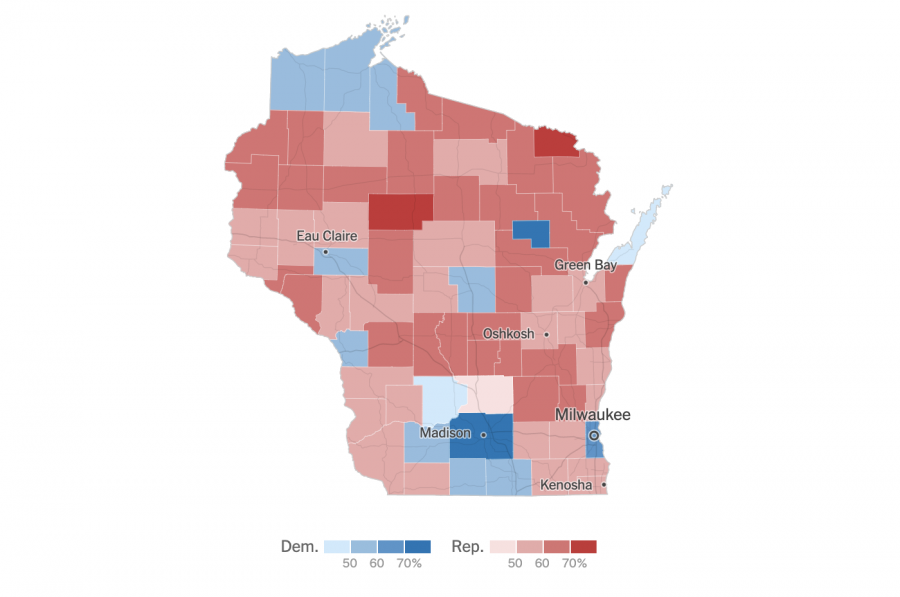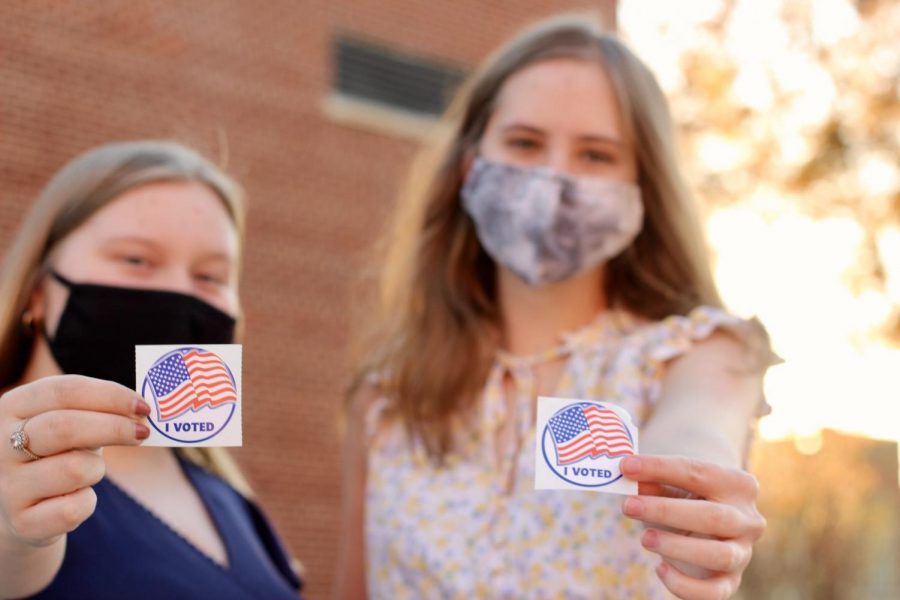Wisconsin voters flip state blue
Eau Claire county and state of Wisconsin show democratic majority, turn of state
More stories from Evelyn Nelson
November 17, 2021

More stories from Lea Kopke
Photo by Evelyn Nelson
Eau Claire is one of 12 counties in the state of Wisconsin which won the Democratic majority in the 2020 presidential election. The election was held on Nov. 3 and Wisconsin’s results were declared Nov. 4.
Key states throughout the Midwest have turned blue in support of Joe Biden, the Democratic presidential candidate. The state of Wisconsin is now one of them, giving Biden 10 additional electoral votes.
On Nov. 4, the Associated Press predicted Biden had won Wisconsin after over 24 hours of collecting and reviewing ballots from Election Day. This was in addition to Biden winning Michigan, one of Wisconsin’s neighboring states, on the same day.
Geoff Peterson, chair of the political science department at UW-Eau Claire, said his area of study and emphasis over the last 25 years has been on American elections.
In comparison to previous years of political trends in Wisconsin, Peterson said he was not overly surprised to see the switch from a previously red state to blue.
“[Wisconsin] was one of the states that we knew was going to be closer based on past presidential elections and the way the governor’s race turned out,” Peterson said. “They are closer than I might have thought they would be, but Wisconsin has been a pretty purple state for a while.”
Biden won with 49.4% and 1,630,541 of votes in Wisconsin, with President Trump in second at 48.8%, securing 1,610,007 votes. The most recent data was collected at 12:15 ET from the New York Times and the Associated Press.
Molly Halverson, a second-year environmental ecology and biology student, said she remembers when Wisconsin turned red in the 2016 election and felt incredibly disappointed in her home state.
Now, with the switch from red to blue, Halverson said she has hope for the future of the nation’s democracy.
“My initial reaction was relief,” Halverson said. “I’m proud of the people of Wisconsin for using their voices and voting, whether they vote blue or red.”
In Eau Claire County, Biden won with a total of 31,617 votes, 54.3%, and Trump collected a total of 25,339 votes, losing at 43.5%.
While Eau Claire’s industrial, economic and health care focuses all play roles in the city’s voting tendencies — which skew left — the university faculty and student pool also makes a difference in the political perspectives brought to Eau Claire, Peterson said.
Members of the university tend to be more likely to vote for the Democratic Party, he said.
Halverson said areas outside of the university and Eau Claire are relatively conservative. She hopes the blue results from Eau Claire and Wisconsin came from the voices of college students who want to make a difference.
“I love being a student in Eau Claire and being on such an open and accepting campus,” Halverson said. “It makes me feel valid having so many people with similar views as me, especially coming from my hometown where mine were not the majority.”
Healthcare corporations like Mayo Clinic, which surround the city, have also made an impact on the county’s voting tendencies.
“People involved in the healthcare industry are more likely to be Democrats as well,” Peterson said. “Because the nature of what they do actually becomes less industrial over time.”
On Nov. 3, on-campus residents at UW-Eau Claire were able to vote in an on-campus location at Zorn Arena on Park and Garfield Ave.
Off-campus students were directed by administrative emails to locate their Eau Claire district and polling place.
The largest impact for seeing Wisconsin turn to blue, Peterson said, was the ability to promote voter turnout among major age demographics that could sway the election.
“The bigger impact has been turnout levels,” Peterson said. “States made mail-in voting much easier to do and in most cases we’re seeing substantially higher turnout than we typically see in a presidential election.”
Other counties in Wisconsin that lead with the democratic vote are Douglass, Bayfield, Ashland, La Crosse, Portage, Menominee, Door, Sauk, Dane, Iowa, Green, Rock and Milwaukee.
Halverson said the Wisconsin flip was a reminder to her that each vote does matter — especially with the high stakes of this election.
“It can be hard with the electoral college to see if your vote actually affects the outcome, especially when the county you voted in favors a different candidate,” Halverson said. “The flip for the nation is just a reminder to get out and participate in these elections, because your voice can be heard and a difference can be made.”
Biden, as of 9:57 p.m. on Nov. 5, has won 253 electoral votes with a popular vote count of 73,201,942 — making him the presidential candidate with the highest voter count in history.
Peterson said Eau Claire was one of the communities the Democratic campaign was counting on, based on their previous track record of being blue compared to other Wisconsin counties.
“I think if we had suddenly all voted for President Trump, it would have shocked the system,” Peterson said. “The vote totals are close enough, statewide, that if we suddenly become a red county, we could have seen the president win the state. The margins are that small.”
Now that Wisconsin is a blue state, Halverson said she would like to see people have more respect for other Democratic government officials in the state. She is also looking forward to seeing how decisions in the 2020 election will drastically shape the future of the nation.
“This election is so important to the American people,” Halverson said. “I’m so happy that Joe Biden won Wisconsin and other surrounding Midwest states. I hope this brings the change America so desperately needs.”
Nelson can be reached at [email protected].

Lea Kopke is a fourth-year journalism and German student. This is her seventh semester on The Spectator staff. She plays the clarinet in the Blugold Marching Band and recently relearned how to ride a bike with no hands.













Woody • Jun 12, 2021 at 11:35 am
Wisconsin will never be a blue state. The only reason it went blue was due to incredible fraud and corruption. Wisconsin residents are the salt of the earth and they do not want more government interference. They want freedom